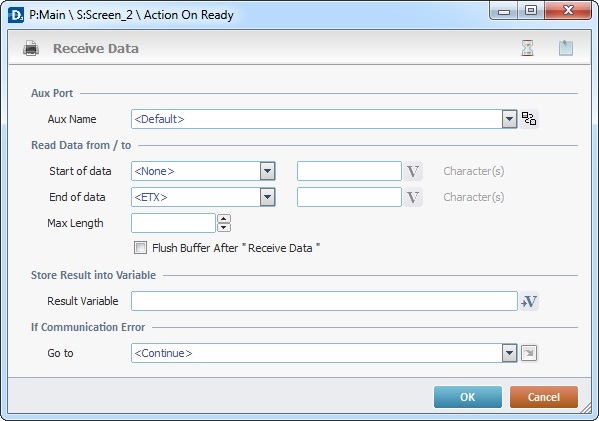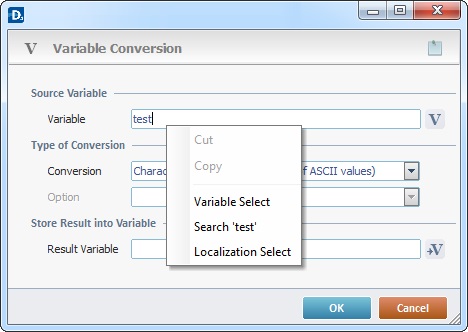Working with Receive Data Process
Process Purpose
The Receive Data process is used to define the structure of the data (type and receiving variables) to be received through a port, from an auxiliary device.
When you add a process, you are required to define its settings. This occurs in the process's properties window which is displayed automatically after having added the Receive Data process.
If any subsequent edition is required, double-click the process to open its properties window and enter the necessary modifications.

Proceed as follows:
Aux Port |
|
Aux Name |
Select the auxiliary device profile that will receive data from the drop-down list. If required, click See To Create an AUX Profile and/or To Edit an AUX Profile. |
Read Data from/to |
|
Start of Data |
Maintain "None" or select the character that identifies the beginning of the received data. See Abbreviations. If you select "Custom", you must define the custom character in the related box which is now active. Enter the intended character or click |
End of Data |
Select the character that identifies the end of the received data. See Abbreviations. If you select "Custom", you must define the custom character in the related box which is now active. Enter the intended character or click If you select "Length", define the intended length in the "Max Length" option. |
Flush Buffer After “Receive Data” |
Check this option to empty the buffer after the received data package is stored in a variable. |
Store Result into Variable |
|
Result Variable |
Click |
If Communication Error |
|
Go to |
Select a target location from the drop-down list or the |
Detail of a ![]() window:
window:

"S:Menu" is a screen included in the same program as the process.
"R:Routine_1" is a routine included in the same program as the process.
Use the following recurring icons (located on the upper right corner of the process window) to execute specific operations:
•Click ![]() to define a time out. See To Define a Time Out.
to define a time out. See To Define a Time Out.
•Click ![]() to attach any relevant notes to this process. Click it and enter your notes in the resulting text box. These notes will be displayed in the corresponding "Actions" tab or "Process" window (in the "Notes" field) and in the "Developer Report".
to attach any relevant notes to this process. Click it and enter your notes in the resulting text box. These notes will be displayed in the corresponding "Actions" tab or "Process" window (in the "Notes" field) and in the "Developer Report".
After filling in the required options, click ![]() to conclude or
to conclude or ![]() to abort the operation.
to abort the operation.
The added process is displayed in the corresponding "Actions" tab or "Process" window.
Abbreviations
This process uses the following abbreviations:
Abbreviation |
Meaning (hexadecimal) |
STX |
Start of Text (02 hex) |
ETX |
End of Text (03 hex) |
CR |
Carriage Return (0D hex) |
LF |
Line Feed (0A hex) |
![]()
Use the right click in MCL-Designer's input boxes to access certain features regarding the input box's option as well as general actions such as "Copy"; "Paste"; "Search".
Ex: If you right-click the "Variable" input box (included in a "Conversion's" properties window), you are provided with the "Search..."and "Variable Select" options.
If you right-click another input box, it will provide other possibilities.
